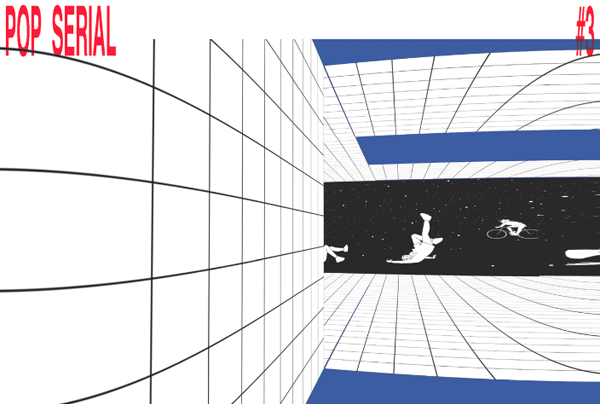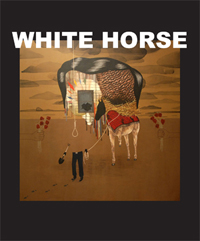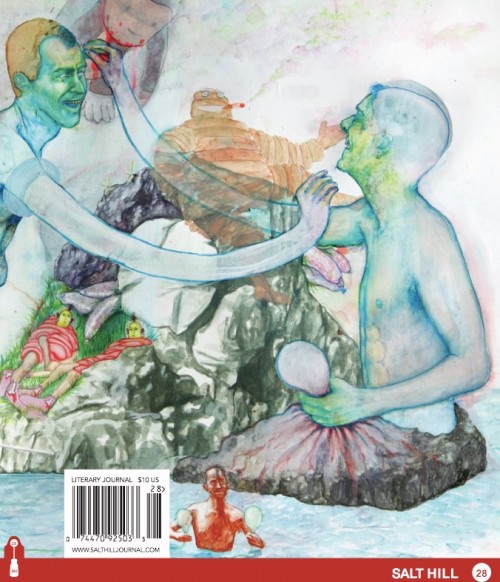Crushed & Filled with All
“I’ve dipped a stranger’s sores in my fat; they require brute force because I love them.” — Sean Kilpatrick
Here is the scene: episode three, season four, Breaking Bad. Jesse Pinkman pulls up to his house, gets out of his little red Toyota Tercel, and walks up to the front door. Exterior. Night. White guy with dreadlocks exits Jesse’s house carrying a red toaster oven. “Check it out,” the dreadlocked white guy says to Jesse, “score, yo!”
Preceding this scene, another scene, the two scenes form a sequence bridged by Fever Ray’s “If I Had A Heart.”
Pop Serial No. 3 Contributor Quiz

Hi. Stephen Tully Dierks here. The third issue of Pop Serial is being serialized online here. A print edition is forthcoming. The magazine also has a regularly updated tumblr with news and things concerning past, present, and maybe future contributors.
The third issue features writing and/or visual art by the following people: Tao Lin, Luna Miguel, Ben Brooks, Sam Pink, Steve Roggenbuck, Blaise Larmee, Frank Hinton, Timothy Willis Sanders, Richard Chiem, Ana Carrete, Crispin Best, Poncho Peligroso, Andrew James Weatherhead, Cameron Pierce, Shaun Gannon, Michael Inscoe, Cassandra Troyan, DJ Berndt, Madison Langston, Zachary Whalen, Liam Bjartrun Adams, Spencer Madsen, Elaine Sun, Jackson Nieuwland, Omar De Col, Stacey Teague, Meggie Green, James Duncan, Cassandra Nguyen, Marshall Mallicoat.
To celebrate, I asked random questions to friends of mine who were on gchat at the time. Omar De Col and I came up with some questions while intoxicated. I gave each person a choice of question. The vague topics/subjects from which to pick were: bloodthirsty Lappet-faced vultures; otters; poop; Omar De Col; fish butt-rape. Some people picked the same question as each other. Fish butt-rape was the most popular question. Below are the questions and responses.
Tao Lin’s Buffer
Over at The Asian American Literary Review Vaman Tyrone X has written an essay about/review of Tao Lin’s recent books: Bed, Shoplifting from American Apparel, and Richard Yates. I enjoyed reading this essay partially because of this point below concerning Lin’s online activity and his writing, which I hadn’t really thought about before in this way. I think, before, I’d always read other critics conflate the two rather than separate them? Anyhow, see what you think.
He wrote an entire (and earnest) essay about Yates’ oeuvre four years before RY was published.[10] Is it really okay to begrudge Lin the right to name his novel after an under-appreciated literary figure that clearly has meant something to him? Or maybe it’s just a more admirable enterprise to protect a now-canonical realist author from Lin’s digital-fame grubbing? The subtext to every sub-positive response to Lin’s work and accompanying personal brand seems to be twofold: (1) “I could write that. I know how to not pile on subordinate clauses too” and (2) “I could become as famous as him if strangers bought shares in my future novels, enabling me to sit, consume kale, and coin acronyms on Twitter.”[11] Fortunately, Lin’s fiction can exist apart from such criticisms because the Lin-ean frame—the megabytes of service he has performed deconstructing ‘Tao Lin,’[12] his style, and his infamy-inducing act[13]—acts as a helpful buffer, [emphasis mine -RC] letting Haley and Dakota wander safely in a traditional realist space without a self-consciously perspiratory narrator forcing them to confront the faults of their maker.
Have a read if you’re so inclined, and I hope all of you are having a lovely day. Take a break from the computer if you can and go for a walk sometime? It’s 60 degrees or so and sunny in Houston and I’m going to take my last class outside, I think.
Predatory by Glenn Shaheen
Well, the dog needs bossing, also the baseball practice (batting balls) and the plumber on the copper pipes (he looks like a man who enjoys a good banging) and the general lack of cheese, shredded. Suddenly there is a rash of either lost cell phones beneath couch cushions or fleeing blackbirds on wing and car doors slamming all around our block and I think to myself this is it, they are coming to take me away. I hold my breath waiting for my garage door to rattle open, loose teeth of nuts and bolts falling, wondering how I am going to get at my toothbrush now that my illicit lover has locked herself into the bathroom (they do this, eventually). But then the government truck farts and rumbles off, there must have been another opportunity at the Walmart across the road. I want to be arrested so that I can read books of poetry, right through from the beginning to the end.
Example, Predatory, by Glenn Shaheen. (It had another more melodramatic title, Shaheen told me, but I forget the exact. It was a beery evening. [I think])
This book is paranoid. Or maybe just ill that way with perception.
All night, a howl
outside the window. All night an animal
is sick.
(Feral Cats)
None of This Is Real
 None of This Is Real
None of This Is Real
by Miranda Mellis
Sidebrow, April, 2012
115 pages / $18 Buy from Sidebrow or SPD
O, the subject of the title story of Miranda Mellis’s collection of short and long fiction, None of This Is Real, seeks solace (he has headaches—better to say “pain management,” then? we’ll see) in something called “Path to a Position™,” purveyed by its shadowy practitioner, Tiara Scuro: “She outlined for O the steps by which he would, with her, find his position. . . The old school believed the antidote for despair was courage, she said, but the real anti to the dote is a comforting distortion; this is what I call somatic realism.” “Somatic” realism? Is there another kind? Or do we deal in phenomenology?
“For years I had been removing the ground from under my clients,” she tells him,
April 23rd, 2012 / 12:00 pm
WHITE HORSE
 White Horse
White Horse
Multi-authored chapbook (Including work by writers: Harold Abramowitz, Saehee Cho, John Cleary, Traci O Connor, Jennifer Denrow, Andrew Farkas, Sandy Florian, Paul Gacioch, Evelyn Hampton, Paul Hardacre, HL Hazuka, Kristen Jorgenson, Carrie-Sinclair Katz, Bob Marcacci, rob mclennan, Shane Michalik, Megan Milks, Cathi Murphy, Eireene Nealand, Kristen Orser, Kristin Prevallet, Zach Savich, Michael Sikkema, Jason Snyder, & James Wagner)
Sidebrow, March 2012
78 pages / $12 Buy from Sidebrow
Being a combinatory effort from a number of authors, it should strike one as no surprise that White Horse seems to be a dialogic narrative. The title remaining somewhat obtuse, save for a specific reference near the end (and tho how can we assume a meaning over all), haunts the work as a whole. In consideration of a multi-authored novel there are two routes one can take—the first being to consider the book as a book, authorless, the second being to consider the book a work of collaboration.
While I had a hope that the book would read authorless, it’s unfortunate that this is not the case. The authors are given attribution at the end of the book, and there are striking divides within the stylistic approaches each few pages take. One can feel the authors who repeat. This posits the book ultimately within the realm of collaboration, and ultimately more of a multi-person dialog than anything else. A novel experiment, it ends up seeming more of an exercise in curation rather than a coherent whole.
April 20th, 2012 / 12:00 pm
I Have A Story For You.
The body count climbs through a series of globewars. Emergent Planetary Commercium trashes the Holy Roman Empire, the Napoleonic Continental System, the Second and Third Reich, and the Soviet International, cranking-up world disorder through compressing phases. Deregulation and the state arms-race each other into cyberspace.By the time soft-engineering slithers out of its box into yours, human security is lurching into crisis. Cloning, lateral genodata transfer, transversal replication, and cyberotics, flood in amongst a relapse onto bacterial sex.Neo-China arrives from the future.
Hypersynthetic drugs click into digital voodoo.
Retro-disease.
Nanospasm.
Students/Teachers: Do you remember reading a story or poem by someone in your creative writing workshop and being truly amazed by it?
Who wrote it? What was interesting or peculiar about it?
{LMC}: An Interview With the Editors of Salt Hill
I love talking to other editors about editing, how they run their magazines, and what they’re thinking about the state of the literary magazine. I had a chance to talk with the editors and designer of Salt Hill to get a sense of the view from Syracuse.
Tell me a little about the history of Salt Hill. Where does the name come from? How long has the magazine been publishing.
Rachel Abelson: The journal has been around for about fifteen years. We are approaching our 30th issue. I’m not sure who is responsible for the name—Michael Paul Thomas was our founding editor—but it’s a reference to the geology of Syracuse. Most of the salt in this country came from Syracuse way back when. There’s a whole museum dedicated to salt here. I believe they reenact the mining of salt pre-1900. I guess Onondaga Lake, besides being wildly polluted, is fed by brine springs. There’s also a lot of snow and a good deal of road salting, too.
Gina Keicher: Salt Hill is run by graduate students in Syracuse University’s Creative Writing Program. It’s a fitting name for a journal based out of the “Salt City.” Also, Syracuse’s campus is situated atop a rather massive hill, so there’s that as well.
What is your editorial process like? How are decisions made? Who has input?
RA: It’s a collaborative process, but there is some autonomy, too, which is key. We often have multiple editors for each genre—poetry, fiction, nonfiction, and art. The goal is for us all to be proud of each section but to avoid editing the life out of something just to ensure we’re unanimous on the matter. Each genre editor is often responsible for a handful of pieces: work they solicited or pulled from slush. These are a genre editor’s babies. And then genre editors work together to build a section around their babies. Editors-in-chief manage separate genres while being responsible for their own pieces as well. Our readers suggest solicitations, too. We’ve worried in the past about over-editing individual pieces. Too many cooks in the track changes. We’re all in MFA mode right now, so we’ve maybe acquired a dangerous instinct to workshop the universe. A degree of editorial autonomy has been our way to respect the stylistic integrity of each piece. If an editor is stoked about a story, she is who will be working with the author on edits and proofing. The logic being: if you like it, you’ll maybe do it justice.
GK: Over the past few years, we’ve also aimed to streamline the process by switching to an online submissions manager, eliminating the paper shuffle. Unsolicited submissions are assigned to readers. If a reader likes a piece she passes it onto the genre editors. If the genre editors are enthusiastic about the piece it goes on to the editors-in-chief. Ultimately, the editors-in-chief make the decisions as to what goes into the journal, taking into account the feedback and comments we receive from readers and genre editors. Throughout our production schedule, editors-in-chief regularly check in with each other, as well as with the genre editors, to determine what may be needed to round out an issue.



